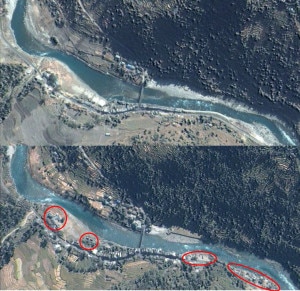(English) Weak geological formation to blame for landslides in HKH region

KATHMANDU, Nepal–Many hilly regions in Nepal have weak geographical formation apart from steep topography structure like many places in the Hindu Kush Himalayan region, which has led frequent change in climate resulting into different types of water-induced hazards, including landslides, avalanche, excessive rainfall, draught among other natural calamities.
Only on Saturday morning, a massive landslide took place at Jure in Sindupalchowk district, some 200 kilometer east of the capital Kathmandu, leaving 156 people dead and many other still missing.
This is not the first time the Sun Koshi valley has experienced a lethal flood, and it will of course not be last time. Like many places around the Hindu Kush Himalayan region, its weak geological formation has made Sun Koshi always prone to different types of hazards, according to the experts.
The valley is also vulnerable to the outburst of growing glacial lakes located in the northern part of the Tibet Autonomous Region of China. In 1981, the Zhangzangbo glacial lake located 20 km upstream from the Nepal-China border breached; the resulting flood caused extensive damage in Nepal from the border down to the village of Dolalghat.
In understanding, photo documentation from 2013 shows a number of scars along the mountain slope in Jure. Experts believe that if there had been an appropriate monitoring mechanism in place, measures could have been taken to raise awareness about the possibility of a larger land slip.
Over the last 30 years, the Sun Koshi valley has experienced three major floods. In 1982, a landslide dam outburst flood (LDOF) in the Balephi River, a tributary of the Sun Koshi, killed 97 people. Another flash flood event in 1987 killed 98 people, and a 1996 flood swept away Larcha village, killing 54 people.
Landslides and other natural disasters are also common outside of the Sun Koshi valley. As per the data of ICIMOD, Nepal alone experienced 13 large landslide events between 1967 and 2010, the most recent being the 2010 Madi landslide in Central Nepal.
Recent natural disasters across the rest of the Hindu Kush Himalayan region include the Swat valley flash flood and Attabad landslide disaster in Pakistan in 2010, the disastrous 2012 Seti flash flood in Nepal, the Uttarakhand disaster in July 2013, and the landslide in Badakhshan, Afghanistan in May this year.
Across the Hindu Kush Himalayan region, improper or insufficient planning of infrastructure and settlements has put unnecessary lives and investments in harm’s way. It is said that unregulated and haphazard development is partially to blame for the severity of the 2013 Uttarakhand disaster.
Landslide missing declared dead
In the meantime, the government on Wednesday has declared dead those who were missing in a massive landslide in Jure of Sindhupalchok. According to the District Administration Office, Sindhupalchok, as many as 123 persons have been pronounced dead who were missing in the landslide that swept away the entire village, Saturday. Bodies of 33 persons have been recovered so far from the incident site.
Meanwhile, the governments of China and India have already offered technical support to the Government of Nepal in its response to the Sun Koshi event.

